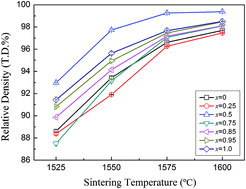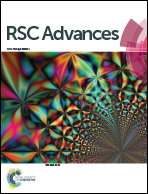Structure and microwave dielectric characteristics of Sr(La1−xSmx)2Al2O7 ceramics
Abstract
Sr(La1−xSmx)2Al2O7 (0 ≤ x ≤ 1) ceramics were synthesized by a standard solid-state reaction method, and the microwave dielectric characteristics were investigated together with the densification behavior, microstructure and phase composition. X-ray diffraction analysis indicated that the matrix phase with Ruddlesden–Popper structure of n = 2 was obtained in the entire composition range. Dense ceramics with relative density of over 96% theoretical density were obtained by sintering at over 1575 °C in air for 3 h. With increasing Sm3+ substitution, the relative dielectric constant increased from 18.8 to 21.3, and the temperature coefficient of resonant frequency was adjusted from −21.7 to 4.8 ppm per °C, while though the Qf value should theoretically decrease with Sm substitution because of the increased interlayer polarization charge, the high Qf was maintained for x < 0.5 and even increased slightly at x = 0.5 due to some extrinsic reasons such as large grain size. The best combination of microwave dielectric characteristics was achieved at the composition of x = 0.5: εr = 21.0, Qf = 115 900 GHz, τf = −3.7 ppm per °C.


 Please wait while we load your content...
Please wait while we load your content...